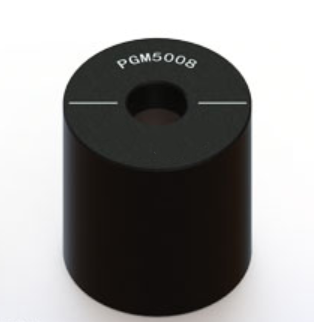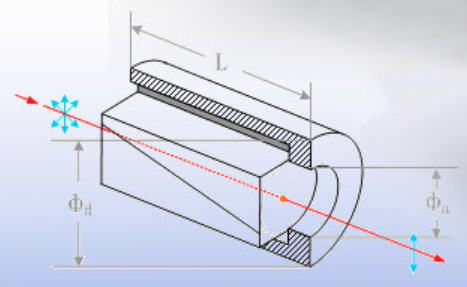Beam Splitters
Polarizing Beam Splitters are an optical device used in various applications to divide a beam of light into two separate beams with distinct polarization states. They are an important component in many optical systems, including microscopy, interferometry, laser systems, and telecommunications.
The basic function of a polarizing beam splitter is to transmit light of a certain polarization while reflecting light of orthogonal polarization. It splits an incoming unpolarized or randomly polarized light beam into two separate output beams: one that retains its original polarization and another that has its polarization perpendicular to the input polarization.
Polarizing beam splitters are constructed using birefringent materials or thin films that exploit the polarization-dependent reflection and transmission properties. The most common type of polarizing beam splitter is made using a combination of a dichroic prism or cube and a thin film polarizer.
The unpolarized or randomly polarized light enters the Polarizing Beam Splitter. The incoming light beam then encounters a dichroic plate, prism or cube, which is made of a birefringent material like calcite or other appropriate crystals. The crystal structure of these materials causes them to exhibit different refractive indices for light polarized parallel and perpendicular to a specific axis. In combination with the dichroic prism/cube, a thin film polarizer is often used to enhance the polarization separation. The thin film polarizer is designed to reflect one polarization state while transmitting the other.
As the light passes through the dichroic prism or cube, its polarization is split into two orthogonal components. One polarization component is transmitted through the prism/cube and the thin film polarizer, while the other polarization component is reflected by the thin film polarizer. The two polarized components of light exit the PBS as separate beams with distinct polarization states. One beam retains the original polarization, and the other beam has its polarization state rotated by 90 degrees.
Polarizing beam splitters are essential tools in optical systems where the separation or manipulation of polarized light is required. They find applications in polarimetry, imaging systems, laser setups, and other fields where precise control over polarization is necessary.
Firebird Optics offers them in both plate and cube configurations for both polarizing and non-polarizing applications. Beam splitters are constructed from high quality glass, calcite and other birefringent materials with tight tolerances on both surface flatness and quality, enabling them to be used in laser applications.
Glan-Thompson Polarizers
Glan-Thompson Polarizers
Firebird Optics’ Glan-Thompson Prisms or Glan-Thompson Polarizers are beamsplitters that consist of two specially cut and cemented calcite prisms with their optical axes arranged perpendicular to each other. When unpolarized light enters the polarizer, they undergo double refraction within the calcite crystals, allowing only one of the resulting polarized beams to pass through, while the other is blocked or significantly attenuated. This unique property makes Glan-Thompson polarizers valuable tools for controlling and analyzing polarized light in optical systems, such as microscopy, spectroscopy, and laser applications.
Glan-Thompson Polarizers: An Introduction to Polarization Optics
Polarization optics is a field in optics focused on handling and studying how light's polarization works, a fundamental aspect of today's optical tech that's vital in areas like microscopy, spectroscopy, and laser applications. The Glan-Thompson Prism, a specialized tool in this field, is commonly employed to split and study polarized light.
What is a Glan-Thompson Polarizer?
The Glan-Thompson polarizer is an optical device designed to selectively transmit light with a specific polarization orientation while blocking light with perpendicular polarization. It consists of two carefully cut and cemented calcite crystals arranged so that their optical axes are perpendicular to each other.
Working Principle of Glan-Thompson Polarizers
The Glan-Thompson Prism functions similar to the Glan-Laser with some specific exceptions. When unpolarized light enters the polarizer, it undergoes double refraction within the calcite crystals, producing two orthogonally polarized output beams. One of these beams is transmitted through the polarizer, while the other is blocked or significantly attenuated.
Traits of Glan-Thompson Polarizers
Key characteristics and advantages of Glan-Thompson prisms include:
High Extinction Ratio: Glan-Thompson prisms offer a high extinction ratio, which means they can efficiently block light with undesired polarization orientations, ensuring the purity of the transmitted or reflected polarized light.
Wide Wavelength Range: These prisms can work effectively across a broad spectrum of wavelengths, making them suitable for a variety of applications in different parts of the electromagnetic spectrum, including visible, infrared, and ultraviolet regions.
Wide Acceptance Angle: Glan-Taylor prisms often have a wide acceptance angle, allowing them to accept light over a range of incident angles.
Low Depolarization: They exhibit low depolarization characteristics, preserving the polarization state of light passing through the prism and minimizing unwanted alterations.
Durability: Glan-Thompson prisms are compact and sturdy optical components, making them easy to integrate into optical systems and resistant to mechanical stress and temperature fluctuations.
Specs for Glan-Thompson Polarizers:
Materials available: Calcite
Wavelength ranges: 400-2300nm
Extinction ratio: Calcite, <5×10-5
Surface Quality: 20-10
Beam Deviation: <3 arc minutes
Flatness: λ/4@633nm
Damage Threshold: >5W/cm2 CW, 1064nm
Coating: Single Layer MgF2 @1064nm, Tp>86% @1064nm
Holder: Black Anodized Aluminum






